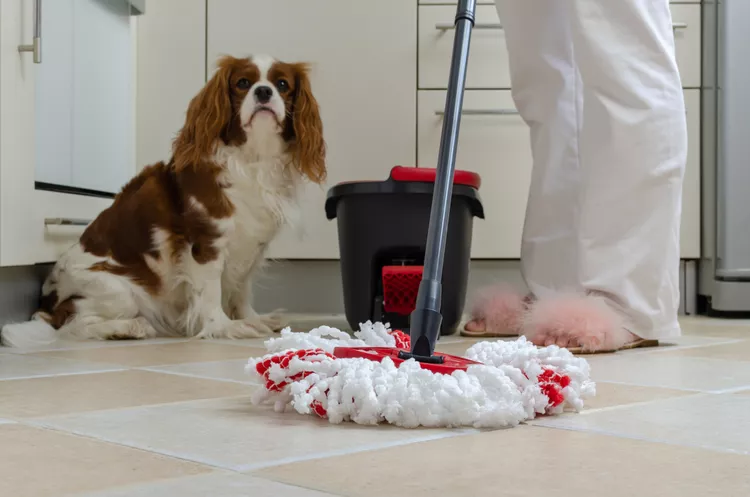Is Swiffer WetJet Safe to Use Around My Pet?

It’s no secret that if you have pets, you’re going to have messes to clean up as well. Whether you share your home with a cat or dog, spot mopping and thorough deep cleaning will become part of your routine. Many people enjoy the ease of a Swiffer WetJet when faced with small spots or tough cleaning jobs created by their pets. But, are the chemicals found in Swiffer WetJets safe to use around pets? Let’s find out.
Is Swiffer WetJet Unsafe Around Pets?
The claim that Swiffer WetJet was unsafe around pets was circulated via email in the early 2000s. The death of a dog and two cats were assumed to have been caused by the chemicals found in the Swiffer WetJet. But, veterinary toxicologists at the ASPCA reviewed the claim and stated that the ingredients were safe to use around pets when used according to label directions and that they do not cause liver damage at the product’s concentrations.
According to Proctor & Gamble’s Material Safety Data Sheet (MSDS), most of the Swiffer WetJet cleaning solution is composed of water: somewhere between 90 and 100 percent. Propylene glycol n-butyl ether and alcohol make up between one and four percent each, with the remainder of the solution comprised of minor ingredients and preservatives.
The urban myth that Swiffer WetJet solution was killing pets arose because of the inclusion of propylene glycol, which is used with ethylene glycol in antifreeze and de-icing products. While ethylene glycol has been shown to pose a threat to pets, propylene glycol has been classified by the Food and Drug Administration (FDA) as an additive that is “generally recognized as safe” for use in food, and is recommended as a safe alternative to ethylene glycol antifreeze products to use around pets.
Also, the ingredient in Swiffer WetJet solution is not propylene glycol, but propylene glycol n-butyl ether, which is an ingredient found in many different brands of cleaning products. Since it is such a common chemical, we should have heard of many more pet deaths if it was truly dangerous.
Warning
The product's pads could be hazardous for pets if they eat the pad. Additionally, it is possible for your pet to consume a large amount of cleaning fluid, which could cause toxicity issues.
Simply put, Swiffer WetJet is safe to use around pets, as long as you follow the label directions. The product’s pads could cause a gastrointestinal blockage if eaten, and a large amount of the cleaning solution could lead to toxicity, but most pets should be smart enough to avoid guzzling the solution.
It is safe to use a Swiffer WetJet on your floors and even allow your pet to walk on them before they are dry. But, to be extra cautious, keep your pet confined in a different room until your floors are dry and ensure that you store the cleaning solution and pads out of reach of your pet.
What Chemicals to Avoid to Keep Your Pet Safe
Pets are nosy creatures and tend to sniff out things that are better left alone. Most households are filled with chemicals designed to eradicate dirt, mold, mildew, rust, weeds, and pests, but these products can poison your pet. When filling your cabinet with household cleaners, be sure your cabinet is tightly secured against inquisitive pets and their prying paws, as the following chemicals can harm your furry friend:
- Bleach
- Drain cleaner
- Detergent
- Nail polish remover
- Paint thinner
- Pesticides
- Herbicides
- Rodenticides
When in doubt about the toxicity status of a particular product, read the label thoroughly or contact the manufacturing company for advice.
Symptoms of Toxicity Poisoning in Your Pet
If your pet manages to sneak her way into your cleaning product cabinet or runs afoul of a chemical, you may notice a few signs of toxicity such as vomiting or diarrhea, unusual body temperature, and shaking.
At the first hint that your pet may have gotten into a chemical, contact your veterinarian immediately. If an incident occurs after their business hours, call your local emergency veterinary hospital or the ASPCA’s poison control center at (888) 426-4435.
How to Clean Your Floors in a Pet-Friendly Way
Avoid the risk of toxicity for your pet by using natural products to clean your floor. We’ve taken the legwork out of finding the safest floor cleaning products to help prevent toxicity in your furry friend. Here is a list of non-toxic floor cleaners safe for use around pets:
- Enzyme Solution Naturally It’s Clean: This floor cleaner uses plant-based enzymes to tackle sticky messes without leaving a tacky residue behind.
- Puracy Natural Multi-Purpose Cleaner: This plant-based cleaner is guaranteed to safely clean any hard surface without streaking, perfect for those nose prints on your glass or paw prints on your floor.
- Nature’s Miracle Stain & Odor Remover: Perfect for carpeted floors, this cleaner harnesses the power of bacteria-eating enzymes to eliminate pet odors and stains.
- Baking soda: While straight baking soda can cause stomach upset, a mixture of baking soda and water or vinegar creates a powerful scrubbing agent that’s non-toxic.
- Vinegar: Vinyl and linoleum floors benefit from this shine-leaving cleaner. Simply mix one cup of distilled white vinegar to one gallon of water and tackle your floor’s toughest messes. Be sure to rinse well afterward, though.
When cleaning your floors and you’re unsure about the toxicity level of your product, be sure to rinse your floor well afterward, keep your pet off your floor until it’s fully dry, and block access to your cleaning products. Many all-natural products don’t require rinsing post-cleaning, so check the label to ensure proper use.